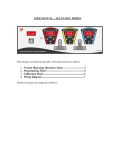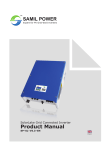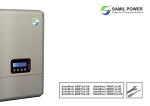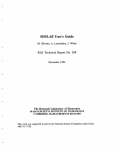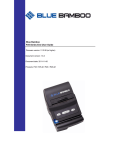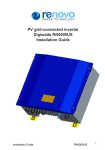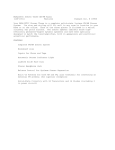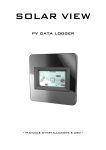Download Product Manual
Transcript
TM SAMIL POWER Expert for PV Grid-tied Inverters SolarPond Product Manual SP-SP-1.0-EN Copyright Declaration The copyright of this manual belongs to Samil Power Co., Ltd. Any corporation or individual should not plagiarize, partially copy or fully copy it (including software, etc.), and should not reproduce or distribute it in any form or by any means. All rights reserved. Samil Power reserves the right of final interpretation. This manual changes according to user’s or customer’s feedback. Please check our website at www.samilpower.com for the latest version. 01 CONTENTS 1 Notes on This Manual 1.1 1.2 1.3 1.4 1.5 Scope of Validity Target Group important Safety Information Important Safety Instructions Symbols Used 2 The SolarPond series Inverter System 2.1 2.2 2.3 2.4 2.5 New Features The Advantage of SolarPond MPPT Protection Function Dimension Product Label 3 Installation 3.1 3.2 3.3 3.4 Installation Process Packaging List Safety Instruction Installation Tools 05 05 05 05 05 05 05 07 07 08 08 09 10 19 19 21 22 4 Commissioning 15 5 Troubleshooting 15 5.1 Troubleshooting an Inoperable Inverter 5.2 Disconnecting the Inverter from the PV Module 5.3 Troubleshooting Tips 6 Technical Data 6.1 6.2 6.3 6.4 DC Parameters AC Parameters Efficiency General data 7 Appendix 02 19 19 21 15 22 23 24 25 27 Notes on This Manual 1 Notes on This Manual This manual is an integral part of the inverter. Please read the product manual carefully before installation, operation or maintenance. Keep this product manual for future reference. 1.1 Scope of Validity This product manual describes the assembly, installation, commissioning, and maintenance of the following Samil Power SolarPond. SolarPond 240HF-US SolarPond240HF-AU 1.2 Target Group This manual is meant for qualified electricians. The tasks described in this manual must only be performed by qualified electricians. 1.3 Important Safety Information Before installation or operation, please read the manual, or contact the local distributor. Please visit the company website: www.samilpower.com for more information. 1.4 Important Safety Instructions When using the product, please remember the following instructions: ● Read all instructions and cautionary markings on the SolarPond series inverter, and all appropriate sections of this guide. ● Perform all electrical installations in accordance with all local and National Electrical Codes (NEC), like ANSI/NFPA 70. ● Only qualified personnel should install and/or replace SolarPond series inverters. ● Do not attempt to repair the SolarPond series inverters; it contains no user serviceable parts. If it fails, please return the unit to your distributor for maintenance. Tampering with or opening the SolarPond series inverters will affect the warranty. ● Connect the SolarPond series inverter to the electrical utility grid as per local regulations which may include prior written approval from the utility company. 1.5 Symbols Used Some symbols are used in this manual in order to ensure personal and property safety. Please read and understand the following symbols carefully. 03 Notes on This Manual & The SolarPond series Inverter System Danger! Danger indicates a hazardous situation, if not avoided, will result in death or serious injury. Note! Note provides tips about the optimal operation when using the product. 2 The SolarPond series Inverter System The SolarPond series inverter is a PV micro inverter which converts the DC power of a PV generator into AC power and feeds it into the public grid. The key elements of a SolarPond series inverter based system are: ● SolarPond series inverter ● SolarWatcher100-zigbee (SW100) ● SolarWatcher Manager Photovoltaic modules Microv-inverters SolarWatcher100 SolarRepeater(optional) Ethernet cable Meter Router SolarWatcher Manager This integrated system maximizes energy harvest, increases system reliability, and simplifies design, installation and management. 04 The SolarPond series Inverter System 2.1 New Features ● ● ● ● ● ● ● ● ● ● Max. efficiency of 96% EURO Efficiency of 94.5% CEC efficiency of 95.5% MPPT efficiency of 99.5% HF transformer Advanced monitoring Outdoor installation&wide operate temperature Excellent protection Long life design with 25-year warranty Simple installation 2.2 Advantage of SolarPond MPPT The SolarPond series inverter maximizes energy production from your photovoltaic (PV) array. Each SolarPond series inverter is individually connected to one PV module in your array. This unique configuration means that an individual Maximum Power Point Tracker (MPPT) controls each PV module. This insures that the maximum power available from each PV module is exported to the utility grid regardless of the performance of the other PV modules in the array. That is, although individual PV modules in the array may be affected by shading, soiling, orientation, or module mismatch, the SolarPond series inverter ensures top performance of each associated PV module. The result is maximum energy production from your PV system. 2.3 Protection Function Anti-islanding protection When the local power grid shuts down because of failure or equipment maintenance, SolarPond series inverter should be physically disconnected safely so as to protect any personnel working on the grid, in full compliance with the applicable prevailing national standards and regulations. Grounding fault Inverters with direct inputs from a grounded photovoltaic array or arrays need to be provided with a ground-fault detector/interrupter (GFDI). The GFDI is capable of detecting ground fault, providing an indication of the fault, interrupting the flow of fault current, and either isolating the faulty array section or disabling the inverter to cease export of power. The GFDI is used only in the SolarPond 240HF-US. More equipment protection SolarPond series inverter can run safely in any working condition because of the following protections: 05 The SolarPond series Inverter System When the ambient temperature is beyond the design operating range, inverter will limit power automatically; Continuous monitoring of power grid to ensure that the voltage and frequency are in the standard range; short-circuit protection, and over/low voltage protection . + - 230.0mm 170.0mm 2.4 Dimensions AC 34.5mm 2.5 Product Label Product label attached to the back of the inverter provides basic information of the unit. Do pay special attention to the type of inverter and other specifications. Model:SolarPond-US MPPT range at full load: Maximum input voltage: Max. DC current: Nominal frequency: Operating frequency range: Output power factor: AC output Voltage: AC output voltage range: 48V >9.5A 60HZ 59.3-60.5Hz 0.95min 240V/208V 211-264V/183-229V AC max. cont. output power: 240W Ambient temperature range: -40℃ to +65℃ P 06 27~40V The SolarPond series Inverter System & Installation 3 Installation 3.1 Installation Process ● Pre install checks Ensure the following before installation: √ Read the user manual carefully; √ Check products and parts; √ Inspection installation tools; √ Check the installation environment. ● Electrical connection Work involved in the electrical connection: √ Connect DC side; √ Connect AC side; √ Ground joint. 3.2 Packaging List Please check the package against the following list to make sure that all the items are in place. If any part is found damaged or missing, please contact your supplier immediately. Item Inverter Set of screw Packing list Manual Warranty card Certification Value 1 1 1 1 1 1 Comments Up to UL1741 and AS standard 07 Installation 3.3 Safety Instruction SolarPond series inverter is easy to install. Each inverter can be quickly mounted on the PV racking, directly beneath each PV module. DC cables connecting the PV modules to inverters carry low DC voltage thereby making this system safer than conventional PV systems having much higher voltages. ● Before installing the SolarPond series inverter, read all instructions and cautionary markings in the user manual, on the SolarPond series inverter, and on the photovoltaic array. ● Perform all electrical installations in accordance with all local electrical codes like National Electrical Code (NEC),and ANSI/NFPA 70. ● Connect the inverter to the electrical utility grid as per local regulations which may include prior approval from the utility company. ● Only qualified personnel should connect the inverter to the electrical utility grid. ● Be aware that installation of this equipment includes risk of electric shock. Normally grounded conductors may become un-grounded and energized when a ground fault is indicated. 3.4 Installation Tools Following tools and parts are needed for installation. ● ● ● ● ● ● Junction box Grounding cable Screwdriver 1/2 and 9/16 inch socket wrenches Wire cutters Wire strippers 3.5 Installation Installing the SolarPond series inverter System involves five key steps: A. Installing the junction box B. Attaching the SolarPond series inverter to the racking C. Grounding the system D. Connecting AC side E. Connecting to the PV modules A. Installing the junction box Step 1: Mount the junction box at the end of rack, ensure that the hole on the junction box match the corresponding hole on the rack. Step 2: Insert the T-headed bolt through junction box and rack holes and tighten the flange nut. 08 Installation T bolt component B. Attaching the SolarPond series inverter to the racking Step 1: Mount the SolarPond series inverter at the appropriate location of the rack. Step 2: Insert the T-headed bolt through junction box and rack holes and tighten flange nut. Step 3: Insert the T-headed bolt with grounding clamp through junction box and rack holes, and tighten flange nut. T bolt component 09 Installation Note! Note provides tips about the optimal operation when using the product. C. Grounding the system Step 1: Fix the copper wire into grounding clamp. Step 2: Tighten the bolt of grounding clamp to fix the copper wire. Earthing lug component D. Connecting AC side Step 1: Connect the first inverter to the first junction box (closest to junction box). Step 2: Repeat for each the inverter. Step 3: Cover the last connector to protect it. Connect 10 Installation One junction box connects up to 24 inverters in a 208V AC mode and 17 inverters in 240V AC mode. Please ensure that the Copper wire used can operate at the maximum current. The minimum-bending radius of AC wire is 40mm. E. Connecting to the PV modules Step 1: Connect the positive cable of PV modules to the negative cable of the inverter. Step 2: Connect the negative cable of PV modules to the positive cable of the inverter. Step 3: Then install the PV module. 11 Installation & Commissioning If the wire is too long, please fasten it to the rack by strapping. The minimum-bending radius of DC wire is 32.5mm. 4 Commissioning Connect the inverter to the electrical utility grid as per local regulations which may include prior approval from the utility company. Be aware that only qualified personnel must connect the inverter to the electrical utility grid. Ensure that all AC and DC wiring is correct. Ensure that none of the AC and DC wires are pinched or damaged. Ensure that all junction boxes are properly closed. To commission the inverter PV system: 1. Turn ON the AC switch on each AC circuit junction box. 2. Turn ON the main utility-grid AC circuit breaker. Your system will start producing power after a five-minute wait time. 3. Verify operation and production by reading the display on the LCD panel of the SW100. Please refer to the SW100 Installation and Operation Manual for information on the SW100. 12 Troubleshooting 5 Troubleshooting Do not attempt to repair the inverter; it contains no userserviceable parts. If it fails, please return the unit to your distributor for maintenance. Be aware that only qualified personnel should troubleshoot the PV array or the inverter. The inverters are powered both by AC power from the utility grid and DC power from the PV modules. Make sure you disconnect both the AC and the DC connections and reconnect either AC or DC power to hear the six start-up beeps. Always disconnect AC power before disconnecting the PV module wires from the inverter. The AC connector of the first inverter in a branch circuit is suitable as a disconnecting means once the AC branch circuit breaker in the load center has been opened. 5.1 Troubleshooting To troubleshoot in case of a faulty inverter, follow the steps in the order shown: 1. Check the connection to the utility grid. Verify the grid voltage and frequency to ensure that these are within allowable ranges shown in the Technical Data section. Verify utility power is present at the inverter in question by removing AC, then DC power. Never disconnect the DC wires while the inverter is producing power. Re-connect the AC power conductor and listen for six short beeps. 2. Check the AC branch circuit interconnection between all the inverters. Verify each inverter is energized by the utility grid as described in the previous step. 3. Make sure that all the AC switches in the junction boxes are functioning properly and are closed. 4. Verify the PV module DC voltage is within the allowable range shown in the Technical Data section. 5. Check the DC connections between the inverter and the PV module. 6. If the problem persists, please call customer support at SamilPower. 5.2 Disconnecting the Inverter from the PV Module To ensure that the inverter is not disconnected from the PV modules 13 Troubleshooting under load, adhere to the following disconnection steps in the order shown: 1. 2. 3. 4. Turn off the AC disconnect on the AC branch circuit junction box. Turn off the utility-grid AC circuit breaker. Disconnect the AC branch circuit connector(s). Using a DC current probe, verify there is no current flowing in the DC wires between the PV module and the inverter. 5. If there is measurable DC current, cover the PV module connected to the inverter with an opaque material. 6. Disconnect the PV module DC wire connectors from the inverter. 7. Remove the inverter from the PV array racking. 5.3 Troubleshooting Tips Alarm message Alarm code AC Frequency Out of Range E001 Causes and solutions The grid frequency is too high or too low, beyond normal working range. In this situation, no action is normally needed as the inverter will be connected to the grid automatically when the grid frequency returns to normal range. If fault continues even after grid supply is resitred, please contact Samil customer service hotline or customer service mailbox. AC Voltage Out of Range E002 The grid voltage is too high or too low, beyond normal working range. In this situation, no action is normally needed as the inverter will be connected to the grid automatically when the grid voltage returns to normal range. If fault continues even after grid supply is resitred, please contact Samil customer service hotline or customer service mailbox. DC Over Voltage E003 DC voltage of photovoltaic panels is too high. (1) Photovoltaic panels and inverter are not compatible. Please check the technical parameters of photovoltaic panels and inverter. (2) Reflection from snow. When light level 14 Troubleshooting Continued: returns to normal, inverter will be connected to the grid automatically. (3) If fault continues, please contact Samil customer service hotline or customer service mailbox. DC Under Voltage E004 DC voltage of photovoltaic panels is too low. (1) Photovoltaic panels and inverter are not compatible. Please check the technical parameters of photovoltaic panels and inverter. (2) Poor sunlight. When light returns to normal inverter will be connected to the grid automatically. (3) Photovoltaic panels may be shaded. Please prevent shading. (4) If fault continues, please contact Samil customer service hotline or customer service mailbox. GFDI Fault E005 If GFDI is more than 1A, inverter will stop generating power. (1) The photovoltaic panels are covered with snow or inverter is operating in damp weather. Please Take necessary action to address the problem. (2) Please contact PV technician to test ground impedance of photovoltaic panels. If the ground impedance is more than 1k ohm, photovoltaic panels may need to be changed. (3) If fault continues, please contact Samil customer service hotline or customer service mailbox. Grid supply failure E006 Grid supply is lost No action is normally required as the inverter will restart when the grid voltage returns to normal range. 15 Troubleshooting Continued: If fault continues, please contact Samil customer service hotline or customer service mailbox. Grid Instability E007 Grid voltage is instable . The followings could cause grid voltage instability (1) (2) (3) (4) Grid voltage out of range. Grid frequency out of range. Grid supply failure Serious grid voltage distortion . No action is normally necessary as the inverter will be connected to the grid automatically when the grid supply returns to normal. If the fault continues please contact Samil customer service hotline or customer service mailbox. Over Temperature E008 Working temperature is too high. (1) The ambient temperature is very high. If possible shift inverter to a cooler location. (2) Inverter output too high. (3) No action necessary as the inverter will work normal when the conditions returns to normal. If the fault continues please contact Samil customer service hotline or customer service mailbox. 6 Technical Data You must match the DC operating voltage range of the PV module with the allowable input voltage range of the inverter. The maximum open circuit voltage of the PV module must not exceed the specified maximum input voltage of the inverter. 16 Technical Data 6.1 DC Parameters SolarPond 240HF-US SolarPond 240HF-AU 250 250 MPPT Voltage Range at Full Load[V] 27~40 27~40 Operating voltage Range[V] 21~48 21~48 Inverter Model Max DC power[W] Maximum input voltage[V] 48 48 Turn On Voltage Range[V] 25~48 26~48 Max DC Input Current (RMS)[A] 9.5 9.5 Max Short Circuit Current[A] 15 15 Ground fault protection[mA] 1000 Maximum input source back-feed current to input source[A] 0 0 SolarPond 240HF-US SolarPond 240HF-AU 6.2 AC Parameters Inverter Model 240 240 Output Power Factor[%] >95% >95% Nominal Voltage Range at 240V nominal[V] AC 211~264 Nominal Voltage Range at 208V nominal[V] AC 183~229 230 (Nominal Voltage) Extended Voltage Range at 240V nominal[V] AC 206~269 Extended Voltage Range at 208V nominal[V] AC 179~232 Max AC output power(-40 to 65℃)[W] Maximum AC Output current at 240V nominal[A] 1.14 Maximum AC Output current at 208V nominal[A] 1.3 Nominal Frequency[Hz] 60 207~264 (Nominal Voltage Range) 1.16 (Maximum AC Output current) 50 17 Technical Data Continued: Nominal Frequency Range[Hz] 59.3~60.5 Extended Frequency Range[Hz] 59.2~60.6 47.5~52.5(Nominal Frequency Range) 20 20 Maximum AC output over current protection[A] Maximum AC output fault current & duration[A] 1.4Arms over 1.5Arms over 3 cycles, 3 cycles, 32.8Apeak 37.8Apeak 1.74ms duration 1.74ms duration High AC Voltage trip limit accuracy[%] ±2.5% ±2.5% Low AC Voltage trip limit accuracy[%] ±2.5% ±2.5% Frequency trip limit accuracy[Hz] ±0.05 ±0.05 Trip time accuracy[ms] ±16.7 ±20 Maximum inverters per 20amp AC branch circuit at 240V nominal 17 Maximum inverters per 20amp AC branch circuit at 208V nominal 24 17 (at 230V nominal) Total Harmonic Distortion of current on input (THDI) <5% <5% 50 50 SolarPond 240HF-US SolarPond 240HF-AU MAX Efficiency[%] 96.0 96.0 EURO Efficiency[%] 95.0 95.0 Power consumption at night[mW] 6.3 Efficiency Inverter Model CEC Efficiency[%] MPPT Efficiency[%] 18 95.5 95.5 >99.5 >99.5 Technical Data & Appendix 6.4 General Data SolarPond 240HF-US SolarPond 240HF-AU Ambient Temperature Range[℃] -40 to +65℃ -40 to +65℃ Ambient Temperature Range at Full Load[℃] -40 to +65℃ -40 to +65℃ Operating Temperature Range (internal) [℃] -40 to +85℃ -40 to +85℃ Storage Temperature Range[℃] -40 to +65℃ -40 to +65℃ Inverter Model Maximum Operating Altitude without Derating[m] Noise[dB] 2000m 3000m 2000m 3000m with derating with derating <30dB <30dB 7 Appendix 208 V mode system wiring diagram :GROUND :L1 :L2 :L3 :NEUTRAL 1 2 3 4 5 1 MICRO INVERTER1 2 3 1 METER PV CELL1 4 5 AC JUNCTION BOX PHASE :L1,L2 PV CELL2 MICRO INVERTER2 PHASE :L1,L3 PV CELL3 MICRO INVERTER3 PHASE :L2,L3 AC CABLE L1 L2 L3 N PE 2 1 5 AC DISTRIBUTION PANEL SOCKET SolarWatcher 100 19 Appendix 240V mode system wiring diagram PV CELL1 2 3 4 1 MICRO INVERTER1 2 3 1 METER L1 L2 N PV CELL2 PV CELL N :GROUND :L1 :L2 :NEUTRAL 1 MICRO INVERTER2 MICRO INVERTER N AC CABLE 4 AC JUNCTION BOX PE 2 1 4 SOCKET SolarWatcher 100 AC DISTRIBUTION PANEL 230V mode system wiring diagram(Australia) PV CELL1 1 2 3 METER MICRO INVERTER1 L N 1 MICRO INVERTER N AC CABLE AC JUNCTION BOX 2 1 3 20 MICRO INVERTER2 3 PE AC DISTRIBUTION PANEL PV CELL N :GROUND :L :NEUTRAL 1 2 PV CELL2 SOCKET SolarWatcher 100 SAMIL POWER CO., LTD. Marketing & Sales Office Factory Add: No.52, Huigu Innovation Park, Huishan District, Add: No.66 Taihangshan Road, Tel: Wuxi, Jiangsu Province, P.R.China 214174 Suyu Economic Development Zone, +86 510 83593131 Suqian City, Jiangsu Province, Fax: +86 510 81819678 P.R.China 223800 E-mail: [email protected] Tel: +86 527 88754666 http://www.samilpower.com Fax: +86 527 84453877



























